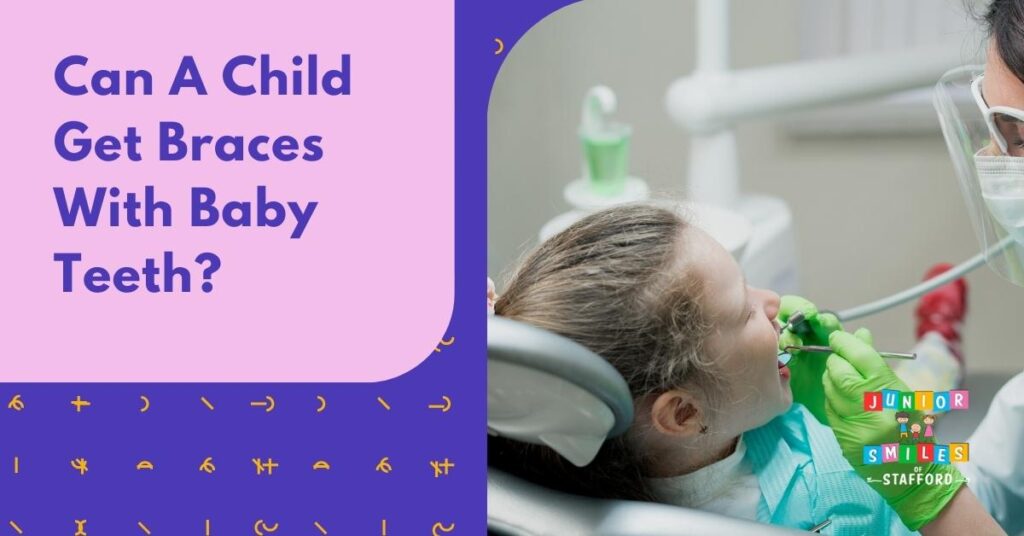Can a Child Get Braces with Baby Teeth?

Can a Child Get Braces with Baby Teeth? | Junior Smiles Of Stafford
Braces are an orthodontic treatment to correct crowding, crookedness, gaps, and misaligned teeth. Doing so can make it easier to clean your teeth and reduce the likelihood of developing cavities and gum disease. They can also improve your appearance by resulting in straighter and perfect teeth.
Braces are typically made from metal, although some versions are now made from ceramic. They consist of brackets glued to the teeth and a wire threaded between them. The wire gradually tightens over time, resulting in the teeth’ movement.
Braces are a common thing among teenagers with alignment issues. However, is it okay for children to have treatment with braces even if they still have their baby teeth? Should a child let their permanent teeth erupt before getting this treatment option? There are a lot of questions about children having this kind of treatment plan; this blog is your answer.
Is It Okay To Start Braces With Baby Teeth?
Yes, it’s sometimes necessary to start braces with baby teeth still present. This phase, known as early orthodontic treatment, addresses dental issues that, if left unattended, could lead to more complex problems as the child grows. Early intervention takes advantage of ongoing facial growth and can be instrumental in managing oral issues, ensuring proper space for incoming permanent adult teeth, and potentially simplifying or reducing future orthodontic treatment needs.
Why Dentists Might Recommend Early Orthodontic Treatment
Dentists might begin orthodontic treatment early for different kinds of issues.
Correcting Bite Problems
Early orthodontic treatment can address several bite issues, such as severe overbite, underbite, or crossbite. These conditions can affect a child’s ability to chew and speak and may lead to uneven wear on the teeth. Correcting these issues early helps promote proper jaw alignment and function.
Guiding Jaw Growth
Dentists initiate early orthodontic interventions to influence and guide the growth of the jaw. This proactive approach ensures that the upper and lower jaws align properly, providing adequate space for the emergence of permanent teeth and fostering better facial symmetry.
Preventing Crowding
Crowded teeth occur when there isn’t enough space in the jaw for all of the child’s incoming teeth. Early orthodontic treatment can help expand the dental arches, providing sufficient space for tooth growth and reducing the likelihood of impaction or the need for tooth removals in the future.
Reducing Treatment Time Later
By addressing orthodontic issues early, dentists can simplify or potentially reduce the need for further treatment when the child is older. Early intervention often means a shorter treatment time during the teen years and can sometimes prevent the need for more invasive dental procedures.
When Can A Child Start Getting Braces?
Children can start getting braces as early as age 6 or 7, especially if they exhibit signs of certain dental or jaw issues. At this age, their jawbones are still developing, and their loss of baby teeth is being replaced by adult teeth. Early evaluation and potential intervention by an orthodontist can guide this development, preventing more serious issues later on. However, the specific timing varies, and a professional consultation is necessary to determine the appropriate start for each child.
What are Factors to Consider?
Before deciding on early braces for a child, several factors need consideration. Firstly, the child’s oral hygiene habits are crucial, as braces require meticulous care to prevent tooth decay. Secondly, the readiness of the child to undergo regular orthodontic visits and potentially prolonged treatment is essential. Financial commitment is another significant consideration, as orthodontic treatments can be costly. Lastly, parents should consider the child’s emotional readiness and ensure understanding and cooperation with the treatment process.
Seek Early Consultation
The American Orthodontic Association states that worried parents should make an orthodontic appointment as soon as they notice a problem with their child’s teeth or if there are missing baby teeth, extra baby teeth, or extra teeth. Even if the parents don’t think there’s anything wrong, they might want to take their child to an orthodontist at age seven. By this age, orthodontists can see very small signs that a child’s teeth, jaw, or bite are not right. Your orthodontist may advise braces or other alternative treatments immediately if early treatment can help prevent severe difficulties in the future. Even so, showing up early doesn’t lock you into anything. In fact, it’s possible that the orthodontist won’t detect anything wrong, and your child may already be on their way to having spaced teeth without the need for intervention.
Read more: Are Toddlers Actually Allowed to Chew Gum?
Contact Junior Smiles of Stafford to Know More About Braces at an Early Age
The decision to start braces with baby teeth is more than just a cosmetic one; it’s a proactive step in ensuring your child’s long-term oral health. Before embarking on this journey, it’s essential to consider factors such as the child’s oral hygiene, emotional readiness, and the financial commitment involved. Remember, the first step is a consultation with a qualified orthodontist who can offer a tailored treatment plan based on your child’s unique needs.
At Junior Smiles of Stafford, we understand the importance of early orthodontic intervention and are dedicated to providing compassionate and expert care. Our team is here to guide you through every step of the process, ensuring your child receives the best possible treatment for a healthy, beautiful smile. Don’t wait until problems become more severe. Contact us today to schedule a consultation and discover how we can help secure a bright dental future for your child.

